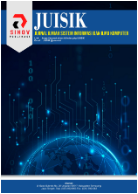Kerangka Kerja Integrasi Kecerdasan Buatan (AI) untuk Formulasi Strategi Bisnis Digital Berbasis Data
DOI:
https://doi.org/10.55606/juisik.v5i1.1497Keywords:
Artificial Intelligence, Decision Making, Digital Strategy, Digital TransformationAbstract
The rapid development of digital technology has encouraged organizations to adopt a data-driven decision-making (DDDM) approach as a primary strategy for maintaining competitiveness amidst a complex and dynamic business landscape. This approach enables more accurate, faster, and fact-based decision-making, thereby enhancing the effectiveness of business strategies. This article aims to formulate a conceptual framework that facilitates the integration of Artificial Intelligence (AI) into the digital business strategy formulation process. This research uses a qualitative approach through a thematic content analysis of reputable scientific literature published between 2019 and 2024. The results of the study indicate that AI plays a strategic role in improving operational efficiency, driving innovation, and strengthening organizational responsiveness to rapid changes in the external environment. AI functions not only as a data analysis tool but also as a driver of business model transformation through predictive capabilities, process automation, and service personalization. However, the successful integration of AI into DDDM is inseparable from several important prerequisites. Key determining factors include adequate digital infrastructure readiness, visionary leadership capable of guiding strategic change, and competent human resources who understand both the technical aspects and strategic implications of AI. On the other hand, challenges faced include organizational cultural resistance to the adoption of new technologies, low data quality and completeness, and a digital skills gap among employees. The conceptual framework proposed in this article maps the linkages between organizational capabilities, AI-enhanced DDDM mechanisms, and the achievement of strategic objectives. This framework is designed to assist organizations in systematically planning, implementing, and evaluating AI integration initiatives. Furthermore, this article provides practical recommendations for business stakeholders in Indonesia, including the importance of investing in digital infrastructure, developing human resource competencies, and establishing an organizational culture that is adaptive to technological innovation.
References
Agrawal, A., Gans, J., & Goldfarb, A. (2022). Prediction machines: The simple economics of artificial intelligence (Updated ed.). Harvard Business Review Press.
Braun, V., & Clarke, V. (2021). Thematic analysis: A practical guide. SAGE Publications.
Creswell, J. W. (2018). Qualitative inquiry and research design: Choosing among five approaches (4th ed.). SAGE Publications.
Davenport, T. H., & Mittal, N. (2023). How generative AI is changing creative work. Harvard Business Review, 101(4), 50–61.
Dwivedi, Y. K., Hughes, L., Ismagilova, E., Aarts, G., Coombs, C., Crick, T., ... & Williams, M. D. (2021). Artificial intelligence (AI): Multidisciplinary perspectives on emerging challenges, opportunities, and agenda for research, practice and policy. International Journal of Information Management, 57, 101994. https://doi.org/10.1016/j.ijinfomgt.2019.08.002
Ghasemaghaei, M. (2019). Are firms ready to use big data analytics for creating value? The role of structural and psychological readiness. Business Horizons, 62(3), 347–356. https://doi.org/10.1016/j.bushor.2019.01.004
Gupta, M., George, J. F., & Xia, W. (2021). Role of data-driven decision making in business strategy and innovation. Journal of Business Research, 128, 487–499. https://doi.org/10.1016/j.jbusres.2021.02.045
Jeble, S., Dubey, R., Childe, S. J., Papadopoulos, T., Roubaud, D., & Prakash, A. (2022). Impact of big data and artificial intelligence on supply chain performance: Evidence from an emerging market. The International Journal of Logistics Management, 33(1), 271–292. https://doi.org/10.1108/IJLM-09-2020-0372
LaValle, S., Lesser, E., Shockley, R., Hopkins, M. S., & Kruschwitz, N. (2020). Data-driven decision making. MIT Sloan Management Review, 62(1), 21–28.
Mikalef, P., Conboy, K., & Krogstie, J. (2022). Big data analytics and business performance: A resource orchestration perspective. Information Systems Frontiers, 24(1), 1–16. https://doi.org/10.1007/s10796-021-10129-y
Mikalef, P., Krogstie, J., Pappas, I. O., & Giannakos, M. (2020). Investigating the effects of big data analytics capabilities on firm performance: The mediating role of dynamic capabilities. Information & Management, 57(2), 103169. https://doi.org/10.1016/j.im.2019.05.003
Shrestha, Y. R., Ben-Menahem, S. M., & von Krogh, G. (2021). Organizational decision-making structures in the age of artificial intelligence. California Management Review, 63(3), 62–83. https://doi.org/10.1177/0008125621992584
Siregar, H., & Fadillah, R. (2023). Strategi integrasi teknologi digital dalam organisasi publik dan swasta di Indonesia. Jurnal Manajemen Teknologi, 22(1), 33–45. https://doi.org/10.1234/jmt.2023.2201
Susanti, N., Indriani, R., & Pratama, A. (2022). Artificial intelligence adoption in Indonesian SMEs: A strategic perspective. Jurnal Teknologi Informasi dan Komunikasi, 10(1), 13–20.
Wamba-Taguimdje, S. L., Fosso Wamba, S., Kala Kamdjoug, J. R., & Tchatchouang Wanko, C. E. (2020). Influence of artificial intelligence (AI) on firm performance: The business value of AI-based transformation projects. Telematics and Informatics, 57, 101509. https://doi.org/10.1016/j.tele.2020.101509
Warner, K. S. R., & Wäger, M. (2019). Building dynamic capabilities for digital transformation: An ongoing process of strategic renewal. Journal of Business Research, 97, 360–370. https://doi.org/10.1016/j.jbusres.2018.10.032
Westerman, G., Bonnet, D., & McAfee, A. (2014). Leading digital: Turning technology into business transformation. Harvard Business Review Press
Downloads
Published
How to Cite
Issue
Section
License
Copyright (c) 2025 Jurnal ilmiah Sistem Informasi dan Ilmu Komputer

This work is licensed under a Creative Commons Attribution-ShareAlike 4.0 International License.










